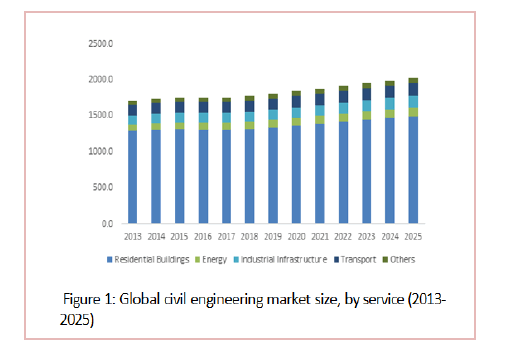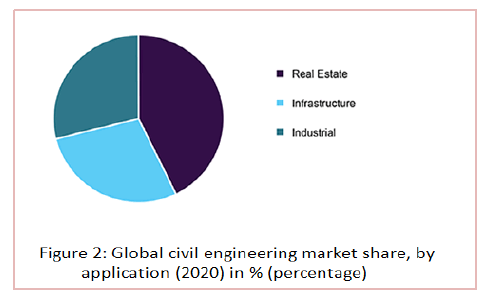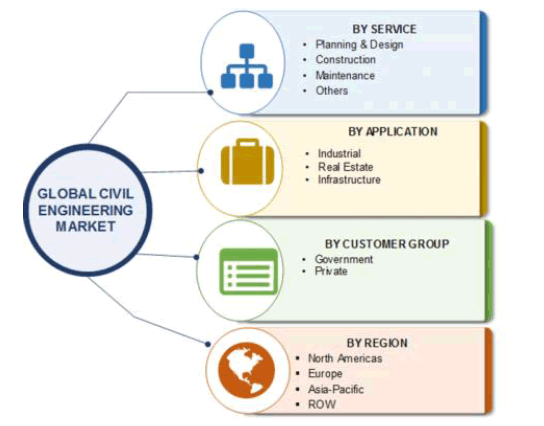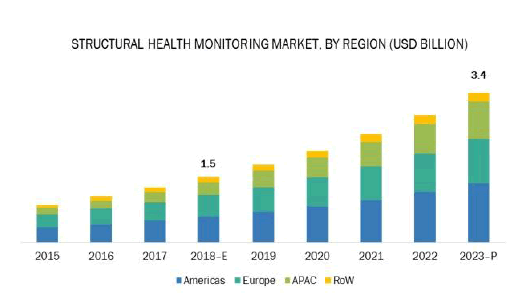The worldwide structural building market size was
esteemed at USD 7.84 trillion of every 2017 and is relied
upon to enrol a CAGR of 5.6% from 2018 to 2025. The
market is anticipated to be driven by an expanding
residential sector in the emerging economies of Asia
Pacific. Rapidly rising urban population, coupled with the
growing need to accommodate them is a key factor
boosting this market. On-going infrastructural
development has also favoured the market, along with
strict government regulations and a rise in international
investments in developing regions such as the Asia
Pacific and the Middle East and Africa (MEA).The market
is anticipated to be driven by an expanding residential
sector in the emerging economies of Asia Pacific. Rapidly
rising urban population, coupled with growing need to
accommodate them is a key factor boosting this market.
On-going infrastructural development has also favoured
the market, along with strict government regulations and
rise in international investments in developing regions
such as Asia Pacific and Middle East and Africa (MEA).
Global civil engineering market size, by service (2013-2025)

Regulations in Europe and North America regarding volatile
organic compounds (VOC) emissions during construction
processes is expected to boost demand for
precast/prefabricated construction products in these regions.
Companies involved in civil engineering all over the world are
increasingly focusing on green building products thanks to
growing awareness about the importance of eco-friendly
products and energy efficiency. Introduction of new materials
and technologies is expected to create lucrative opportunities
for players over the next few years.
Various government regulatory frameworks, such as
the International Building Code (IBC), are applied to new
and existing buildings in order to track and register
specific infrastructure w.r.t. government processes and
control illegal and unethical construction practices.

The construction sector is a key segment within the
market, driven largely by booming building and
construction activities in Asia Pacific and MEA. This is
supported by various international companies and
associated service providers investing in these regions.
India, China, Saudi Arabia, UAE, and other developing
countries are expected to show significant growth in
infrastructural development during the forecast period.
Civil engineering is one of the most prominent and vital
elements in regional development. Infrastructural
development significantly depicts potential growth
possibilities of any regions.
Service Insights
The planning and style phase dominated the market
with a share of over twenty four.44% in terms important
in 2017. It is one in all the initial stages and distinguished
part of engineering science services and so wide in
demand. In addition, the segment is expected to register
the highest CAGR of 6.3% over the forecast period. The
construction sector dominated the world engineering
science market in 2017 with a share of twenty
seven.82%. Recent advances in construction material and equipment are expected to revolutionize the
industry and boost the segment’s share in the coming
years. Maintenance services are crucial for ensuring the
proper functioning and condition of architectures and
infrastructure in the market. Various external environmental conditions area unit live and contractors
ought to keep these in mind and conduct periodic
maintenance. The segment is slated to register a CAGR of 5.9% over the forecast period.
Customer Insights
Government emerged because the dominant phase
on the idea of client and accounted for a forty one.6%
share in 2017 attributable to varied favourable policies
and frameworks.
Need for rapid industrialization to meet needs of
ever-increasing population is likely to drive the segment
to reach USD 5.01 trillion by 2025 at a CAGR of 5.5%
over the forecast period. Governments around the world
have also been making large-scale investments to
improve infrastructure in their respective countries and
provide affordable housing to the population.
The private sector is poised to witness the fastest
growth over the forecast period, fuelled by availability of
large funds. On an individual level, rise in consumer
disposable income and increased spending on
households will drive this segment.
Regional Insights
Asia Pacific is that the largest regional market and is
characterised by simple availableness of land and
complete labour at low value. Shift in world production
landscape has favoured rising economies, notably China
and Asian country that is probably going to influence
market growth over the forecast amount.
Most APAC countries are expected to witness high
economic growth over the forecast period, despite slow
growth in developed regions such as U.S. and Europe.
Thriving construction sector is likely to drive the APAC
market to register strong growth over the forecast period,
exhibiting a CAGR of 5.2%.
Civil Engineering Market Share Insights
Global players dominate the industry and are majorly
concentrated in Asia Pacific, North America, and Europe.
Key makers contribute over forty.0% to the global market
for civil engineering, with a substantial share emerging
from China and U.S. Pricing and different strategic project
initiatives are extremely hooked in to prime players.
Manufacturers focus on formulating innovative business
strategies in order to maintain their position in the
market, acquisitions being a vital growth tactic.
Companies are finance heavily in analysis and
development facilities and are introducing innovative
operations and practices
Segments Covered in the Report:
This report forecasts revenue growth at global, regional, and country and provides an analysis of latest industry
trends and opportunities in each of the sub-segments
from 2014 to 2025. For the purpose of this study, Grand
View Research has segmented the global civil engineering
market report based on service, application, customer,
and region:

Service Outlook (Revenue, USD Billion, 2014 - 2025)
✤ Planning & Design
✤ Construction
✤ Maintenance
✤ Others
Application Outlook (Revenue, USD Billion, 2014 - 2025)
✤ Real Estate
✤ Infrastructure
✤ Industrial
Customer Outlook (Revenue, USD Billion, 2014 - 2025)
✤ Government
✤ Private
✤ Others
Regional Outlook (Revenue, USD Billion, 2014 - 2025)
✤ North America
✤ U.S.
➢ Canada
✤ Europe
➢ Germany
➢ Russia
➢ U.K.
✤ Asia Pacific
➢ China
➢ India
➢ Australia
✤ Central & South America
➢ Brazil
✤ Middle East and Africa
➢UAE
➢ Saudi Arabia
➢Qatar
The structural-engineering industry is being rocked by a
sizable earthquake:
There area unit with great care several elementary trade
factors moving the longer term of structural engineering,”
says David Odeh, principal at Odeh Engineers. “One
scenario is that engineers become irrelevant.” That’s a
significant skilled concern among structural engineers, and
their anxiety is generally driven by 3 factors. First, the large
advances in pc modelling have light-emitting diode to
considerably a lot of complicated structures. “It’s almost a
self-fulfilling prophecy, or a feedback loop,” Odeh says.
“More advanced modelling and analysis leads to more
complex designs and that results in however a lot of
complicated proposals, that demand even a lot of
advanced pc tools.” But paradoxically, as ancient
engineering tasks area unit progressively machinecontrolled,
actual engineers will appear (and feel) minor.
This is the second factor: “When ancient tasks area unit
turned over to advanced solutions, supplemented by
cloud-enabled access to scheming power, the reduction in
engineer time, and needed talent, can be enormous,”
Odeh says. On the surface, it would appear as if structural
engineers might go the manner of the archosaurian. “For
example, choosing member sizes for steel-frame structures
may be a task that wont to need days of conscientious
work, as a structural engineer worked from tables and
exercised hefty judgment,” Odeh says. “Now, that’s nearly
a trivial task—for a one hundred,000-square-foot building,
it will take seconds, and also the ensuing style are going to
be a lot of precise and higher optimized.” and the third
factor is global competition. “Everything we have a
tendency to do is currently influenced by the unfold of
knowledge—it is solely not true that structural engineering
talent is targeted within the us,” Odeh says. “Like it or not,
that affects our profession powerfully.

It’s a frustrating “perfect storm” of things that appears
to threaten one among the infrastructure industry’s
most revered talent sets. It’s ironic—how will advances
in computing that build engineers a lot of capable
conjointly build them appear less necessary? “Some
designers and contractors are beginning to ask, ‘Why do
we even need engineers?’” Odeh says. “To them, if a
program can do it, engineers become superfluous.”





